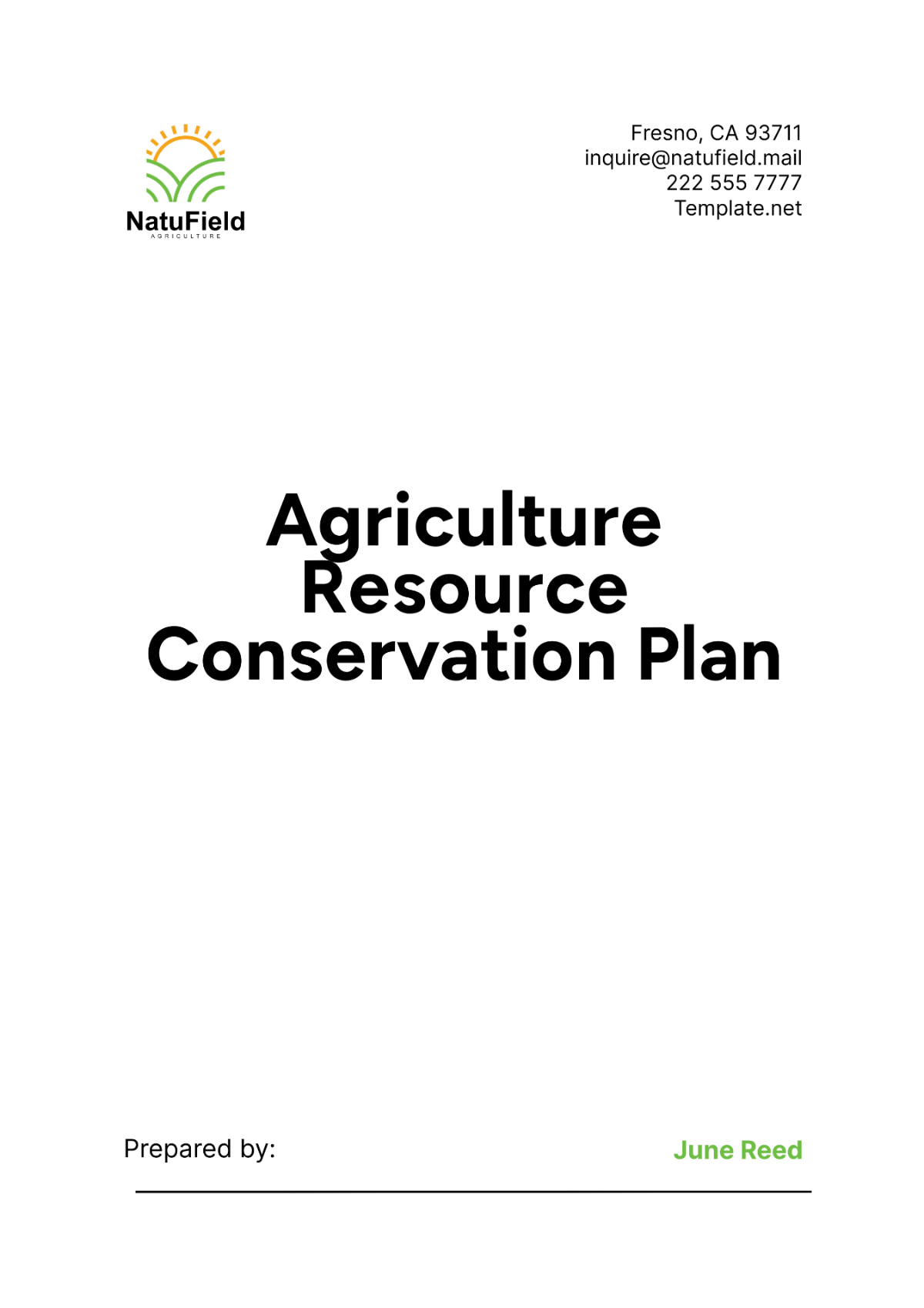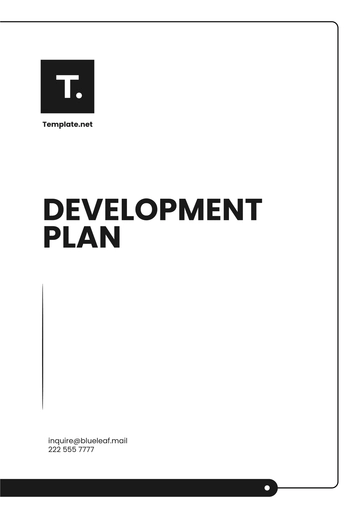Free Agriculture Resource Conservation Plan

I. Executive Summary
This Agriculture Resource Conservation Plan of [Your Company Name] is designed to improve the efficiency and sustainability of resource usage in our agricultural operations. This plan addresses key areas such as water management, soil conservation, energy use, and waste reduction. By implementing these strategies, we aim to enhance our environmental stewardship while also reducing operational costs and improving crop yields.
Our current resource usage analysis reveals significant opportunities for improvement. Optimizing our irrigation systems can lead to water savings of up to 30%, while adopting conservation tillage practices can enhance soil health and reduce erosion by 20%. Financially, these conservation measures are expected to save approximately $50,000 annually, which can be reinvested into further sustainability initiatives.
This plan outlines actionable steps to achieve our conservation goals, with detailed strategies for each key area. Through a combination of best practices, technology adoption, and continuous monitoring, [Your Company Name] is committed to fostering a sustainable and resilient agricultural system.
II. Water Management
A. Irrigation Efficiency
The following table summarizes our current irrigation practices and proposed improvements:
No. | Irrigation Practice | Current Usage (L/ha) | Proposed Usage (L/ha) | Reduction |
|---|---|---|---|---|
1 | Flood Irrigation | 10,000 | 7,000 | 30% |
2 | Drip Irrigation | 6,000 | 5,000 | 16.7% |
3 | Sprinkler Irrigation | 8,000 | 6,400 | 20% |
Flood Irrigation: Currently, we use 10,000 L/ha for flood irrigation. By switching to more efficient methods, such as drip irrigation, we can reduce water usage by 30%, conserving significant water resources and reducing costs.
Drip Irrigation: Our drip irrigation system uses 6,000 L/ha. With proper maintenance and optimization, we aim to reduce this to 5,000 L/ha, achieving a 16.7% reduction in water usage while maintaining crop health.
Sprinkler Irrigation: The current usage for sprinkler irrigation is 8,000 L/ha. By upgrading to more efficient sprinkler heads and better scheduling, we can reduce this to 6,400 L/ha, resulting in a 20% water savings.
B. Rainwater Harvesting
System Installation: Install rainwater harvesting systems on all farm buildings to capture and store rainwater for irrigation use. This reduces dependence on groundwater and municipal water supplies.
Storage Capacity: We plan to increase our storage capacity to accommodate peak rainfall periods. Larger storage tanks ensure that harvested rainwater is available throughout the growing season.
Distribution Network: Develop an efficient distribution network for harvested rainwater to ensure that it is utilized effectively across all fields, maximizing water use efficiency.
Monitoring and Maintenance: Regular monitoring and maintenance of rainwater harvesting systems are essential to ensure optimal performance and longevity.
III. Soil Conservation
A. Conservation Tillage
The following table highlights the impact of conservation tillage practices on soil health:
No. | Practice | Current Erosion (t/ha) | Proposed Erosion (t/ha) | Reduction |
|---|---|---|---|---|
1 | Traditional Tillage | 10 | 6 | 40% |
2 | Reduced Tillage | 8 | 5 | 37.5% |
3 | No-Till | 5 | 3 | 40% |
Traditional Tillage: Traditional tillage practices lead to soil erosion of 10 t/ha. By adopting reduced tillage methods, we can lower erosion to 6 t/ha, achieving a 40% reduction and improving soil structure and fertility.
Reduced Tillage: Currently, reduced tillage results in 8 t/ha of soil erosion. By further minimizing soil disturbance, we aim to reduce this to 5 t/ha, enhancing soil health and reducing erosion by 37.5%.
No-Till: No-till practices are highly effective, currently resulting in 5 t/ha of erosion. Our goal is to decrease this to 3 t/ha, achieving a 40% reduction and promoting sustainable soil management.
B. Cover Cropping
Erosion Control: Plant cover crops to protect the soil from erosion, especially during off-seasons. This practice maintains soil structure and prevents nutrient loss.
Soil Fertility: Cover crops contribute to soil fertility by fixing nitrogen, adding organic matter, and improving soil structure. This reduces the need for chemical fertilizers.
Weed Suppression: Cover crops compete with weeds, reducing their growth and minimizing the need for herbicides. This promotes a healthier crop environment.
Biodiversity Enhancement: Diverse cover crops enhance biodiversity, supporting beneficial organisms and improving ecosystem resilience.
IV. Energy Use
A. Renewable Energy Adoption
The following table outlines our current energy usage and proposed renewable energy adoption:
No. | Energy Source | Current Usage (kWh) | Proposed Usage (kWh) | Reduction |
|---|---|---|---|---|
1 | Diesel | 100,000 | 70,000 | 30% |
2 | Electricity | 80,000 | 60,000 | 25% |
3 | Solar | 0 | 30,000 | New Source |
Diesel: Currently, we use 100,000 kWh of diesel energy annually. By integrating more efficient machinery and practices, we aim to reduce this by 30%, lowering our carbon footprint and fuel costs.
Electricity: Our electricity consumption is 80,000 kWh per year. By adopting energy-efficient technologies and practices, we plan to cut this usage by 25%, resulting in significant cost savings and reduced emissions.
Solar: Introducing solar energy to our operations will add 30,000 kWh of renewable energy, reducing our reliance on non-renewable sources and promoting sustainability.
B. Energy Efficiency Measures
Equipment Upgrades: Upgrade to energy-efficient equipment to reduce energy consumption and operational costs. This includes tractors, irrigation systems, and processing machinery.
Building Insulation: Improve insulation in farm buildings to reduce energy needed for heating and cooling. This enhances energy efficiency and lowers utility bills.
Lighting Systems: Switch to LED lighting and optimize light usage to reduce electricity consumption. This simple yet effective measure contributes to overall energy savings.
Energy Audits: Conduct regular energy audits to identify areas for improvement and track progress. This ensures continuous improvement in energy efficiency.
V. Waste Reduction
A. Waste Management Practices
The following table summarizes our current waste generation and proposed reduction measures:
No. | Waste Type | Current Generation (t/year) | Proposed Generation (t/year) | Reduction |
|---|---|---|---|---|
1 | Crop Residues | 200 | 150 | 25% |
2 | Plastic Waste | 50 | 30 | 40% |
3 | Chemical Containers | 20 | 10 | 50% |
Crop Residues: We currently generate 200 t/year of crop residues. By composting and utilizing residues for bioenergy, we aim to reduce this by 25%, enhancing soil health and reducing waste.
Plastic Waste: Plastic waste amounts to 50 t/year. By adopting biodegradable alternatives and recycling programs, we plan to cut this waste by 40%, minimizing environmental impact.
Chemical Containers: We generate 20 t/year of chemical containers. Through better management and recycling initiatives, we aim to halve this waste to 10 t/year, promoting safer disposal practices.
B. Recycling and Reuse
Composting: Compost organic waste such as crop residues and food waste to turn them into valuable soil amendments. This reduces landfill waste and enhances soil health.
Recycling Programs: Implement recycling programs for plastics, metals, and paper to reduce landfill waste and conserve resources. This promotes a circular economy within our operations.
Reusable Containers: Use reusable containers for chemicals and other inputs to minimize waste generation. This practice reduces costs and environmental impact.
Waste Segregation: Establish waste segregation practices to ensure proper disposal and recycling of different waste types. This improves waste management efficiency.
VI. Biodiversity Conservation
A. Habitat Restoration
The following table details our habitat restoration efforts and proposed outcomes:
No. | Habitat Type | Current Area (ha) | Proposed Area (ha) | Increase |
|---|---|---|---|---|
1 | Wetlands | 50 | 75 | 50% |
2 | Woodlands | 30 | 45 | 50% |
3 | Grasslands | 40 | 60 | 50% |
Wetlands: Our current wetland area is 50 ha. By restoring and expanding these habitats to 75 ha, we aim to increase biodiversity and improve water quality, achieving a 50% increase in wetland area.
Woodlands: Woodlands currently cover 30 ha. Expanding this to 45 ha enhances biodiversity, provides habitat for wildlife, and sequesters carbon, resulting in a 50% increase.
Grasslands: We have 40 ha of grasslands. Increasing this to 60 ha supports a wider range of species and improves soil health, achieving a 50% increase in grassland area.
B. Wildlife Corridors
Corridor Creation: Establish wildlife corridors to connect fragmented habitats, allowing species to move freely and maintain genetic diversity. This enhances ecosystem resilience.
Monitoring Programs: Implement monitoring programs to track the success of wildlife corridors and inform adaptive management strategies. Regular monitoring ensures corridor effectiveness.
Community Involvement: Engage local communities in corridor creation and maintenance to foster collaboration and increase project success. Community support is crucial for long-term sustainability.
Funding and Resources: Secure funding and resources for wildlife corridor projects to ensure their implementation and maintenance. This includes government grants and private investments.
VII. Financial Implications
A. Investment in Conservation
The following chart and table outline our financial investment in conservation initiatives:
No. | Initiative | Investment |
|---|---|---|
1 | Water Management | $40,000 |
2 | Soil Conservation | $35,000 |
3 | Energy Efficiency | $30,000 |
4 | Waste Reduction | $20,000 |
5 | Biodiversity Conservation | $25,000 |
Total | $150,000 |
Water Management: Investing $40,000 in water management initiatives, such as upgrading irrigation systems and implementing rainwater harvesting, enhances water use efficiency and reduces costs.
Soil Conservation: Allocating $35,000 to soil conservation practices, including conservation tillage and cover cropping, improves soil health and reduces erosion, enhancing long-term productivity.
Energy Efficiency: A $30,000 investment in energy efficiency measures, such as renewable energy adoption and equipment upgrades, lowers energy consumption and operational costs.
Waste Reduction: Spending $20,000 on waste reduction initiatives, such as recycling programs and composting, minimizes waste generation and promotes sustainable practices.
Biodiversity Conservation: Investing $25,000 in biodiversity conservation efforts, such as habitat restoration and wildlife corridors, supports ecosystem health and resilience.
B. Financial Returns
Cost Savings: Implement conservation initiatives for significant cost savings, including reduced water and energy bills, lower chemical inputs, and decreased waste disposal costs. These savings enhance overall profitability.
Increased Yields: Conservation practices improve soil health, water efficiency, and biodiversity, leading to increased crop yields. Higher yields translate into greater revenue and financial stability.
Market Premiums: Commitment to sustainable practices attracts market premiums for environmentally friendly products. Consumers are willing to pay more for products that support conservation efforts.
Risk Mitigation: Conservation measures enhance resilience against climate change, pests, and diseases, reducing financial risks associated with crop failures and ensuring stable income.
VIII. Recommendations
A. Enhance Water Management
Upgrade Irrigation Systems: Continuously upgrade and maintain irrigation systems to improve water use efficiency. This reduces water consumption and operational costs while ensuring adequate crop hydration.
Expand Rainwater Harvesting: Increase rainwater harvesting capacity and improve distribution networks. Utilizing harvested rainwater reduces dependence on external water sources and enhances sustainability.
Implement Precision Irrigation: Adopt precision irrigation technologies to optimize water usage based on crop needs. This reduces water wastage and enhances crop health.
Educate Farmers: Provide training and resources to farmers on efficient water management practices. Educated farmers are better equipped to implement sustainable water use strategies.
B. Improve Soil Health
Increase Organic Matter: Enhance soil organic matter through composting and cover cropping. Organic matter improves soil structure, fertility, and water retention.
Adopt Conservation Tillage: Implement conservation tillage practices to reduce soil erosion and improve soil health. Minimal soil disturbance enhances soil structure and biodiversity.
Regular Soil Testing: Conduct regular soil testing to monitor nutrient levels and soil health. This information guides precise fertilizer applications and soil management practices.
Promote Agroforestry: Integrate agroforestry practices to enhance soil health and biodiversity. Trees and shrubs improve soil structure, provide habitat, and support ecosystem services.
C. Strengthen Energy Efficiency
Adopt Renewable Energy: Increase the adoption of renewable energy sources, such as solar and wind power, to reduce reliance on non-renewable sources. This enhances sustainability and lowers energy costs.
Upgrade Equipment: Continuously upgrade to energy-efficient equipment and technologies. This reduces energy consumption and operational costs while improving productivity.
Implement Energy Audits: Conduct regular energy audits to identify areas for improvement and track progress. This ensures continuous improvement in energy efficiency.
Promote Energy Conservation: Educate staff and farmers on energy conservation practices. Increased awareness and training lead to more efficient energy use and cost savings.
IX. Conclusion and Next Steps
A. Conclusion
This Agriculture Resource Conservation Plan of [Your Company Name] outlines comprehensive strategies to enhance resource usage efficiency and sustainability. Through improved water management, soil conservation, energy efficiency, and waste reduction, we aim to reduce operational costs, increase productivity, and support environmental stewardship.
The financial investment in these initiatives is expected to yield significant returns, including cost savings, increased yields, and market premiums for sustainably produced products. By implementing the recommendations provided, [Your Company Name] can achieve a more sustainable and resilient agricultural system.
B. Next Steps
To move forward with the implementation of this conservation plan, we propose the following next steps:
Engage Stakeholders: Involve all stakeholders, including farmers, staff, and local communities, in the planning and implementation process to ensure collaboration and support.
Implement Monitoring Systems: Establish monitoring systems to track the progress and effectiveness of conservation initiatives. Regular monitoring ensures continuous improvement and adaptation.
Provide Training and Education: Offer training and educational programs to farmers and staff on best practices for resource conservation. Knowledge and skills are critical to successful implementation.
By following these steps, [Your Company Name] can effectively implement the Agriculture Resource Conservation Plan and achieve its sustainability goals.
- 100% Customizable, free editor
- Access 1 Million+ Templates, photo’s & graphics
- Download or share as a template
- Click and replace photos, graphics, text, backgrounds
- Resize, crop, AI write & more
- Access advanced editor
Improve resource usage with our Agriculture Resource Conservation Plan Template! Fully editable, this template allows for precise customization to your conservation strategies. Available on Template.net, it features customizable sections for seamless branding integration. The AI Editor Tool enhances efficiency, ensuring a comprehensive plan tailored to your agricultural resource conservation goals!
You may also like
- Finance Plan
- Construction Plan
- Sales Plan
- Development Plan
- Career Plan
- Budget Plan
- HR Plan
- Education Plan
- Transition Plan
- Work Plan
- Training Plan
- Communication Plan
- Operation Plan
- Health And Safety Plan
- Strategy Plan
- Professional Development Plan
- Advertising Plan
- Risk Management Plan
- Restaurant Plan
- School Plan
- Nursing Home Patient Care Plan
- Nursing Care Plan
- Plan Event
- Startup Plan
- Social Media Plan
- Staffing Plan
- Annual Plan
- Content Plan
- Payment Plan
- Implementation Plan
- Hotel Plan
- Workout Plan
- Accounting Plan
- Campaign Plan
- Essay Plan
- 30 60 90 Day Plan
- Research Plan
- Recruitment Plan
- 90 Day Plan
- Quarterly Plan
- Emergency Plan
- 5 Year Plan
- Gym Plan
- Personal Plan
- IT and Software Plan
- Treatment Plan
- Real Estate Plan
- Law Firm Plan
- Healthcare Plan
- Improvement Plan
- Media Plan
- 5 Year Business Plan
- Learning Plan
- Marketing Campaign Plan
- Travel Agency Plan
- Cleaning Services Plan
- Interior Design Plan
- Performance Plan
- PR Plan
- Birth Plan
- Life Plan
- SEO Plan
- Disaster Recovery Plan
- Continuity Plan
- Launch Plan
- Legal Plan
- Behavior Plan
- Performance Improvement Plan
- Salon Plan
- Security Plan
- Security Management Plan
- Employee Development Plan
- Quality Plan
- Service Improvement Plan
- Growth Plan
- Incident Response Plan
- Basketball Plan
- Emergency Action Plan
- Product Launch Plan
- Spa Plan
- Employee Training Plan
- Data Analysis Plan
- Employee Action Plan
- Territory Plan
- Audit Plan
- Classroom Plan
- Activity Plan
- Parenting Plan
- Care Plan
- Project Execution Plan
- Exercise Plan
- Internship Plan
- Software Development Plan
- Continuous Improvement Plan
- Leave Plan
- 90 Day Sales Plan
- Advertising Agency Plan
- Employee Transition Plan
- Smart Action Plan
- Workplace Safety Plan
- Behavior Change Plan
- Contingency Plan
- Continuity of Operations Plan
- Health Plan
- Quality Control Plan
- Self Plan
- Sports Development Plan
- Change Management Plan
- Ecommerce Plan
- Personal Financial Plan
- Process Improvement Plan
- 30-60-90 Day Sales Plan
- Crisis Management Plan
- Engagement Plan
- Execution Plan
- Pandemic Plan
- Quality Assurance Plan
- Service Continuity Plan
- Agile Project Plan
- Fundraising Plan
- Job Transition Plan
- Asset Maintenance Plan
- Maintenance Plan
- Software Test Plan
- Staff Training and Development Plan
- 3 Year Plan
- Brand Activation Plan
- Release Plan
- Resource Plan
- Risk Mitigation Plan
- Teacher Plan
- 30 60 90 Day Plan for New Manager
- Food Safety Plan
- Food Truck Plan
- Hiring Plan
- Quality Management Plan
- Wellness Plan
- Behavior Intervention Plan
- Bonus Plan
- Investment Plan
- Maternity Leave Plan
- Pandemic Response Plan
- Succession Planning
- Coaching Plan
- Configuration Management Plan
- Remote Work Plan
- Self Care Plan
- Teaching Plan
- 100-Day Plan
- HACCP Plan
- Student Plan
- Sustainability Plan
- 30 60 90 Day Plan for Interview
- Access Plan
- Site Specific Safety Plan





























